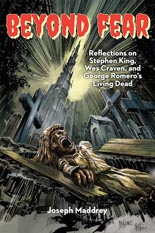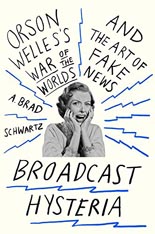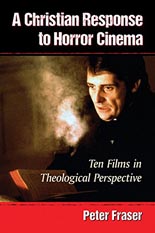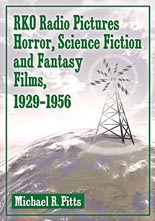 In naming his new book, Joseph Maddrey chose the wrong preposition: Beyond Fear is about fear. What the Bear Manor Media trade paperback is beyond is the usual quality of film bios seen in the indie-pub field — miles above, no less. The subtitle teases Reflections on Stephen King, Wes Craven, and George Romero’s Living Dead, which is to say essays about these terror titans’ lives and work, but imbued with threads of personality from Maddrey (perhaps best known for 2004’s Nightmares in Red, White and Blue and its subsequent 2009 documentary), all ridiculously readable. Romero actually represents just a smidge of the 336 pages, while Craven is more fleshed out, including a new-to-me nugget of how A Nightmare on Elm Street almost was made for Disney Channel. Clearly, Maddrey’s heart and soul lie with King, and it’s a testament to the volume that even if Romero and Craven’s parts were shaved away, your money still would be well-spent. He provides an enlightening encapsulation of the writer’s entire career — peaks, valleys and coke-fueled bumps — with particular attention paid to each novel’s germination. I devoured it like Constant Readers do King’s books.
In naming his new book, Joseph Maddrey chose the wrong preposition: Beyond Fear is about fear. What the Bear Manor Media trade paperback is beyond is the usual quality of film bios seen in the indie-pub field — miles above, no less. The subtitle teases Reflections on Stephen King, Wes Craven, and George Romero’s Living Dead, which is to say essays about these terror titans’ lives and work, but imbued with threads of personality from Maddrey (perhaps best known for 2004’s Nightmares in Red, White and Blue and its subsequent 2009 documentary), all ridiculously readable. Romero actually represents just a smidge of the 336 pages, while Craven is more fleshed out, including a new-to-me nugget of how A Nightmare on Elm Street almost was made for Disney Channel. Clearly, Maddrey’s heart and soul lie with King, and it’s a testament to the volume that even if Romero and Craven’s parts were shaved away, your money still would be well-spent. He provides an enlightening encapsulation of the writer’s entire career — peaks, valleys and coke-fueled bumps — with particular attention paid to each novel’s germination. I devoured it like Constant Readers do King’s books.
 In the mood for a good debunking? Are you sure? Because you might be disappointed to learn that the Mercury Theatre’s 1938 radio adaptation of a certain H.G. Wells novel did not cause widespread panic after all. Note: The operative word there is “widespread,” because as A. Brad Schwartz proves in Broadcast Hysteria: Orson Welles’s War of the Worlds and the Art of Fake News, uproar did result — just not in the teeming masses as legend has it. Kind of a book-length Snopes entry, but actually entertaining and readable, the Hill and Wang hardcover release makes its factual case while also delivering a stranger-than-fiction account of the real story behind the unreal story, full of eye-opening letters from listeners both outraged and amused. Given Welles’ eventual F for Fake documentary on hoaxes and forgeries, one would think the filmmaker himself would appreciate Schwartz’s stats-backed correction of “history”; on the other hand, he certainly ate up the post-War attention.
In the mood for a good debunking? Are you sure? Because you might be disappointed to learn that the Mercury Theatre’s 1938 radio adaptation of a certain H.G. Wells novel did not cause widespread panic after all. Note: The operative word there is “widespread,” because as A. Brad Schwartz proves in Broadcast Hysteria: Orson Welles’s War of the Worlds and the Art of Fake News, uproar did result — just not in the teeming masses as legend has it. Kind of a book-length Snopes entry, but actually entertaining and readable, the Hill and Wang hardcover release makes its factual case while also delivering a stranger-than-fiction account of the real story behind the unreal story, full of eye-opening letters from listeners both outraged and amused. Given Welles’ eventual F for Fake documentary on hoaxes and forgeries, one would think the filmmaker himself would appreciate Schwartz’s stats-backed correction of “history”; on the other hand, he certainly ate up the post-War attention.
 Don’t assume from the title of his new book, A Christian Response to Horror Cinema: Ten Films in Theological Perspective, that Peter Fraser is condemning the entire horror genre; while many deeply devout consider such entertainment to be satanic at face value, Fraser finds interest — and even pleasure — in viewing depictions of the light and the dark. In fact, he argues for their co-existence, despite not having a particular affinity for scare cinema. (This will not surprise you when he admits upfront that What Lies Beneath gave him “night terrors.”) Just over half the book is devoted to old-school chillers, one of which grants the McFarland-published paperback its highlight: his discussion of 1973’s The Exorcist. As he writes, while William Friedkin’s classic conjures evil onscreen, “the paradox … is that the story was apparently written and put onto film to lead people toward the faith.” I’ve made that argument before to deaf and deeply religious ears, so it’s refreshing to read the same from an open (if too easily frightened) mind.
Don’t assume from the title of his new book, A Christian Response to Horror Cinema: Ten Films in Theological Perspective, that Peter Fraser is condemning the entire horror genre; while many deeply devout consider such entertainment to be satanic at face value, Fraser finds interest — and even pleasure — in viewing depictions of the light and the dark. In fact, he argues for their co-existence, despite not having a particular affinity for scare cinema. (This will not surprise you when he admits upfront that What Lies Beneath gave him “night terrors.”) Just over half the book is devoted to old-school chillers, one of which grants the McFarland-published paperback its highlight: his discussion of 1973’s The Exorcist. As he writes, while William Friedkin’s classic conjures evil onscreen, “the paradox … is that the story was apparently written and put onto film to lead people toward the faith.” I’ve made that argument before to deaf and deeply religious ears, so it’s refreshing to read the same from an open (if too easily frightened) mind.
 As news arrives of Showtime reviving (or maybe not) David Lynch and Mark Frost’s weird, wonderful Twin Peaks television series, Andy Burns’ Wrapped in Plastic: Twin Peaks arrives as part of the second wave of ECW Press’ line of Pop Classics paperbacks. Judged as a free-flowing, long-form essay stemming from one man’s mind, Burns’ book works; judged as a story of the show’s making, it fails. (But it’s not meant to be that, for which I steer you toward Brad Dukes’ oral history, Reflections.) Small in size and page count, but not intelligence, Wrapped considers (and reconsiders) how damn risky the series was, its depiction of ultimate family dysfunction, and how influential it remains today in this age of “auteur television,” despite its all-too-brief broadcast life. Because the Pop Classics line lets its authors run wild, the results read deeply personal, if not always relatable; it depends upon your own love for each volume’s under-the-microscope subject. (For those keeping track, that has included Showgirls, the Teenage Mutant Ninja Turtles and Elvis Costello, with Nicolas Cage to follow this fall.)
As news arrives of Showtime reviving (or maybe not) David Lynch and Mark Frost’s weird, wonderful Twin Peaks television series, Andy Burns’ Wrapped in Plastic: Twin Peaks arrives as part of the second wave of ECW Press’ line of Pop Classics paperbacks. Judged as a free-flowing, long-form essay stemming from one man’s mind, Burns’ book works; judged as a story of the show’s making, it fails. (But it’s not meant to be that, for which I steer you toward Brad Dukes’ oral history, Reflections.) Small in size and page count, but not intelligence, Wrapped considers (and reconsiders) how damn risky the series was, its depiction of ultimate family dysfunction, and how influential it remains today in this age of “auteur television,” despite its all-too-brief broadcast life. Because the Pop Classics line lets its authors run wild, the results read deeply personal, if not always relatable; it depends upon your own love for each volume’s under-the-microscope subject. (For those keeping track, that has included Showgirls, the Teenage Mutant Ninja Turtles and Elvis Costello, with Nicolas Cage to follow this fall.)
 It is what it is: RKO Radio Pictures Horror, Science Fiction and Fantasy Films, 1929-1956. The hefty paperback from McFarland sees Michael R. Pitts covering every film that meets the book’s title criteria, from Adventure Girl to Zombies on Broadway. With even short subjects thrown in for good measure, the contents are presented alphabetically vs. chronologically. For RKO nuts — and believe me, they’re out there, given the studio’s runs with King Kong, Dick Tracy, Walt Disney, Val Lewton and Tarzan — the admittedly niche book should prove a welcome reference. For more general film lovers, only Pitts’ own critiques and historical perspective provide any sustenance, as IMDb has eliminated the need for comprehensive cast-and-crew credits, and I hear from a growing number of people that lengthy plot synopses are space-wasters as well. As per McFarland’s usual standards, original key art is widespread and tops. —Rod Lott
It is what it is: RKO Radio Pictures Horror, Science Fiction and Fantasy Films, 1929-1956. The hefty paperback from McFarland sees Michael R. Pitts covering every film that meets the book’s title criteria, from Adventure Girl to Zombies on Broadway. With even short subjects thrown in for good measure, the contents are presented alphabetically vs. chronologically. For RKO nuts — and believe me, they’re out there, given the studio’s runs with King Kong, Dick Tracy, Walt Disney, Val Lewton and Tarzan — the admittedly niche book should prove a welcome reference. For more general film lovers, only Pitts’ own critiques and historical perspective provide any sustenance, as IMDb has eliminated the need for comprehensive cast-and-crew credits, and I hear from a growing number of people that lengthy plot synopses are space-wasters as well. As per McFarland’s usual standards, original key art is widespread and tops. —Rod Lott
